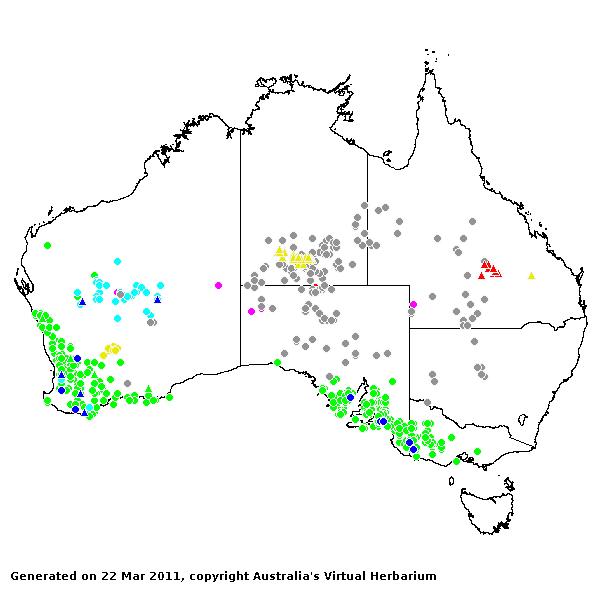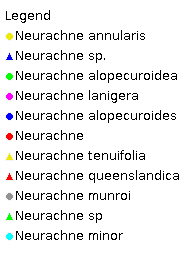Neurachne Prodr. 196 (1810).
Derivation:. From Greek neuron (nerve) and achne (glume), alluding to the many-nerved outer glumes.
Taxonomic revisions, nomenclatural references:. S.T.Blake, Contr. Qld Herb. 13:5–19 and figs (1972).
Key references (keys and floras):. G.Bentham, Flora Australiensis 7: 507–508 (1878); C.A.Gardner, Flora of Western Australia 1 Gramineae 271–274 (1952); J.W.Vickery, Flora of New South Wales, Gramineae 19: 72–74 (1961); M.Lazarides, Flora of Central Australia 484–485 (1981); J.C.Tothill and J.B.Hacker, Grasses of Southern Queensland 312–313 (1983); J.P.Jessop, Flora of South Australia 4: 1981–1982 (1986); R.D.Webster, Australian Paniceae 106–111 (1987); B.K.Simon, Key to Australian Grasses 133–134 (1993); S.W.L.Jacobs and C.A.Wall, Flora of New South Wales 4: 451(1993); N.G.Walsh, Flora of Victoria 2: 582–583 (1994); D.Sharp and B.K.Simon, AusGrass (2002); D.Sharp and B.K.Simon, AusGrass (2002); J.P.Jessop, Grasses of South Australia 499–502 (2006); S.W.L.Jacobs, R.D.B.Whalley & D.J.B.Wheeler, Grasses of New South Wales, 4th ed, 306 (2008).
W.D.Clayton & S.A.Renvoize, Genera Graminum (1986), genus (445).
Native, endemic. 6 species, from arid mainland Australia. WA, NT, SA, Qld, NSW, and Vic.
Habit. Perennial, tufted (from short rhizomes). Leaf blades narrow. Ligule a fringe of hairs.
Inflorescence. Inflorescence a single spike (almost, in N. munroi) or a single raceme (spike-like, or even capitate to ovoid in N. alopecuroidea and N. minor), a single raceme or spike, contracted.
Spikelets. Spikelets dorsally compressed, 2 flowered, with 1 fertile floret, solitary, sessile (or almost so) or subsessile or pedicelled (the pedicels short). Fertile spikelets with lower incomplete floret(s), lanceolate, abaxial (with lower glume on side away from rachis), falling with glumes.
Glumes. Glumes more or less equal, long relative to adjacent lemmas (exceeding them), hairy (especially marginally), pointed (acuminate), awned or awnless, dissimilar to similar (both rigidly membranous, ovate-acuminate to lanceolate-subulate and becoming hardened towards the base, the lower ciliate or not, the upper with a dense narrow sub-marginal beard of long white hairs on each side below). Lower glume 3–7 nerved. Upper glume 7–13 nerved.
Florets. Lower incomplete floret(s) male. Lemmas awnless, 5–7 nerved, more or less equalling fertile lemmas, similar in texture to fertile lemmas to decidedly firmer than fertile lemmas, not becoming indurated. Fertile florets 1. Lemmas less firm than glumes (membranous to hyaline, in N. munroi smaller and flimsier than the palea), smooth, not becoming indurated (hyaline or membranous), white in fruit, muticous, without a germination flap, 0–5 nerved, glabrous, having flat margins not tucked into palea. Palea relatively long, entire, textured like lemma, 2 nerved. Lodicules 2. Stamens 3. Grain small, trigonous. Hilum short. Embryo large.
Kranz Anatomy. C4 (N. munroi, which has an `extra' sheath) or C3 (N. alopecuroidea, N. lanigera, N. queenslandica, N. tenuifolia; N. minor is a C3/C4 intermediate), biochemical type when C4 , NADP-ME (N. munroi).
2n = 18, 36, and 54 (rarely 37, 53), 2, 4, and 6 ploid (and some aneuploids).
Habitat. Xerophytic. Heath, sandstone, light woodland and scrub. Species of open habitats.
Classification. Panicoideae; Neurachneae.
Notes. Neurachne, Paraneurachne and Thyridolepis are traditionally placed in an endemic Australian tribe the Neurachneae (Blake, 1972). However recent cladistic work based on morphological characters (Zuolaga, Morrone and Giussani, 2000) reveal that Neurachneae is not monophyletic, and the three genera are placed widely among the Paniceae in the cladogram (B.K.Simon).
Types Species. N. alopecuroidea R.Br.
Biogeographic Element. Clifford & Simon 1981, Simon & Jacobs 1990: Endemic


